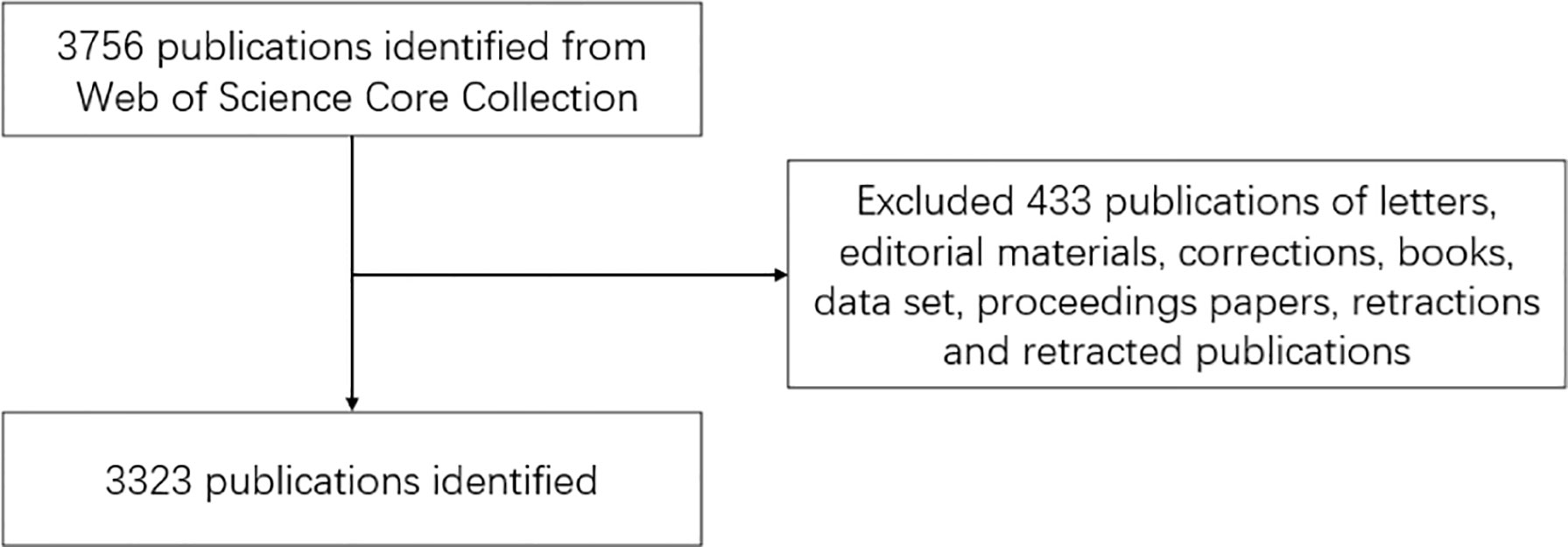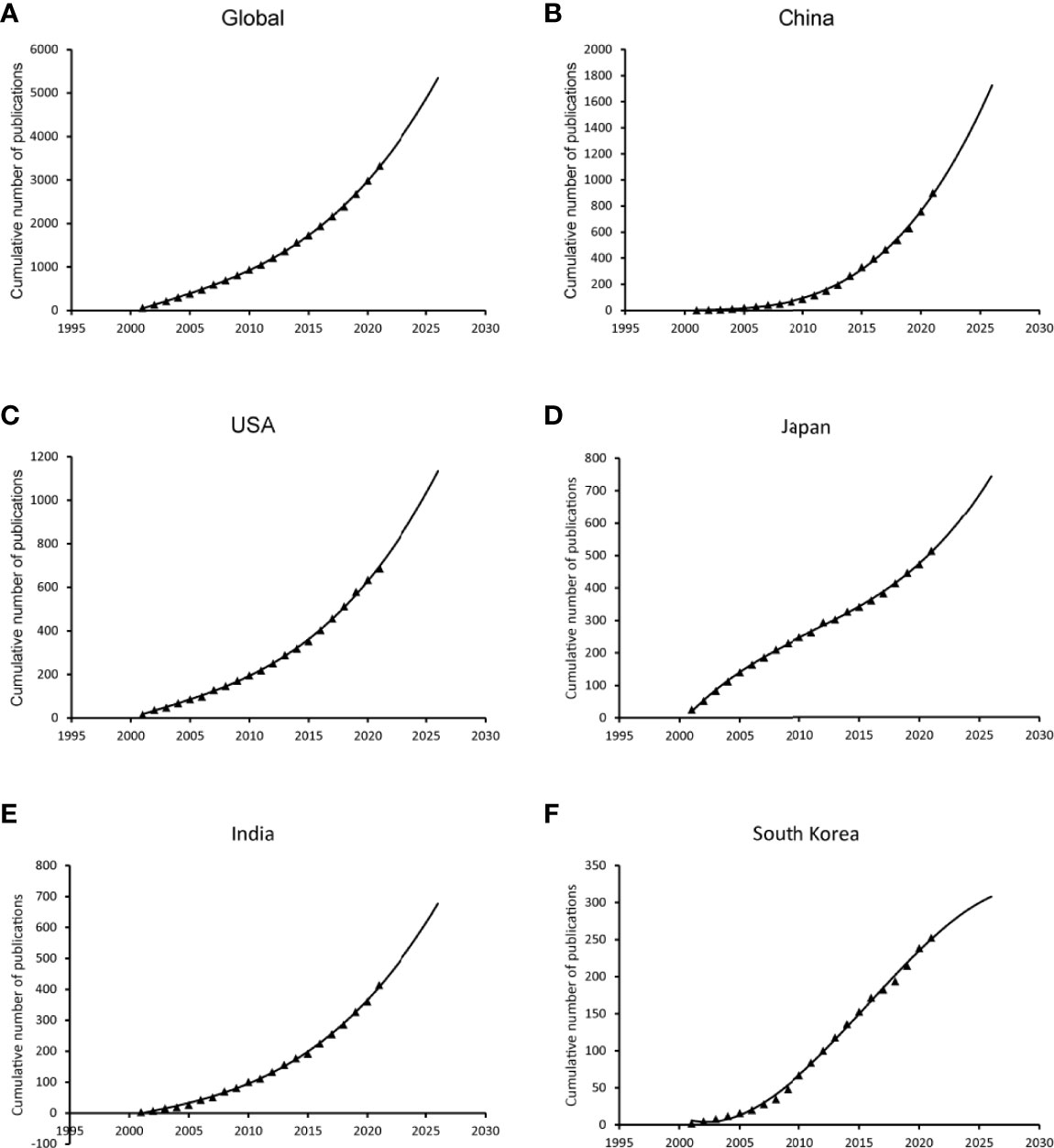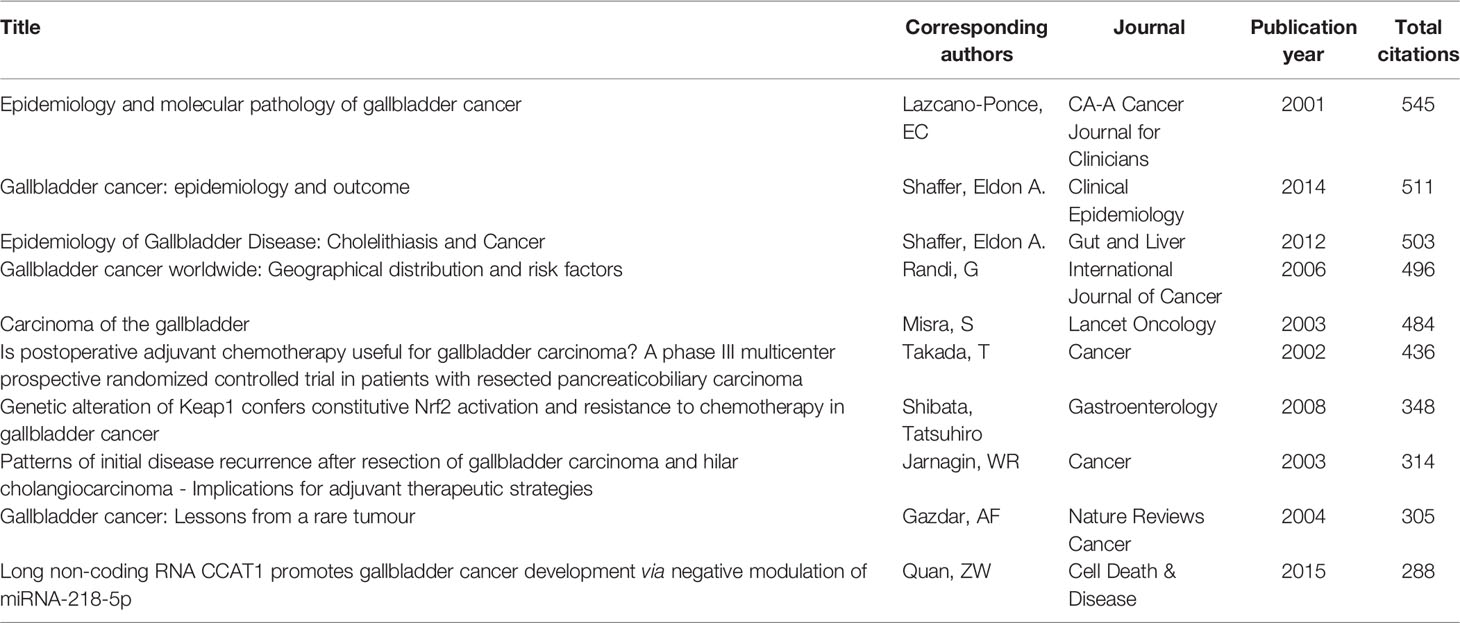- 1Department of General Surgery, Zhongshan Hospital, Fudan University, Shanghai, China
- 2Biliary Tract Disease Institute, Fudan University, Shanghai, China
- 3Shanghai Engineering Research Center of Biliary Tract Minimal Invasive Surgery and Materials, Shanghai, China
- 4Department of Nuclear Medicine, Zhongshan Hospital, Fudan University, Shanghai, China
Gallbladder cancer (GBC) is one of the lethal cancers with an extremely poor prognosis. In the recent 20 years, research on GBC has developed rapidly. Here we aim to perform a systematical bibliometric analysis on the current foci and status of GBC research. This study analyzes trends in GBC research and compares contributions from different countries and regions, institutions, and authors. All publications in GBC research from 2001 to 2021 in the Web of Science Core Collection (WoSCC) database were collected. Microsoft Excel 2010 and GraphPad Prism 9 were used to analyze publication data and publication trends. VOSviewer 1.6.17 was adapted to generate a visual network of keywords in surgical training research. A total of 3,323 publications were included. China was the most productive country, with the highest number of publications (n = 900, 27.08%). Shanghai Jiaotong University and Roa JC were the most productive institution and authors, contributing 215 and 89 publications, respectively. Keywords were classified into five clusters, each representing a key topic. The main clusters of GBC are related to surgery therapy, mechanism research-related study, and non-surgery therapy, while migration is the current hotspot of GBC research. The scientific progression of GBC research over the past two decades was comprehensively analyzed by this bibliometric study. Finding deeper mechanisms in the migration of GBC cells, new biomarkers, and highly effective nomograms will be the major problems and directions in the future.
Introduction
Gallbladder cancer (GBC) is the most common cancer in biliary tract malignancy, accounting for 80%–95% of biliary tract malignancy by autopsy studies (1). It is one of the most malignant cancers due to its latency, late clinical detection, and very dismal prognosis (2). The incidence of GBC varied among regions. East Asia, East Europe, and Latin America contribute the highest incidence of GBC (3), which may result from environmental exposures, genetic predisposition, and regional intrinsic risk factors (1). Radical surgery remains the only potentially curative treatment, but only 10% of patients have the opportunity to have radical resection (2). Most patients need therapy including chemotherapy based on gemcitabine as a first-line regimen and radiotherapy (4, 5). However, the median overall survival is less than 1 year and the 5-year survival rate remains low at approximately 5% (6–8).
Due to the poor prognosis, GBC has been the subject of extensive research over the past two decades. Emerging therapy regimens like targeted therapy and immunotherapy show potential efficacy. For example, regorafenib, a multitargeted receptor tyrosine kinase inhibitor, significantly improved PFS in patients with previously treated metastatic/unresectable biliary tract cancer (BTC) including GBC, but the effect on GBC needs more subgroup analysis (9). Patients with refractory BTC or MSI-H/dMMR tumors may benefit from immune checkpoint inhibitors like pembrolizumab and nivolumab (10, 11). Moreover, better understanding of the mechanism in GBC has emerged over the years. Whole-exome sequencing, targeted gene sequencing, and single-cell RNA sequencing depict an atlas of GBC at the molecular level and uncover the essential factors and molecular mechanism in gallbladder carcinogenesis (12–14).
Bibliometric analysis has become a popular and reliable method to evaluate detailed trends in a certain field over time. It applies literature metrology characteristics to measure contributions in a certain field and predict the trends and developments. Till now, there is no bibliometric analysis that focused on GBC. To better retrospect the development and contributions and prospect the future hot spots in GBC research, we present a comprehensive and in-depth analysis on the current state of GBC research based on Web of Science Core Collection (WoSCC) data and provide an insight into the direction and trend in GBC research.
Materials and Methods
Data Collection and Search Strategies
We used the WoSCC database to collect literature data. All searches were completed on March 20, 2022. The filtering strategy was set to “(TI=(gallbladder tumor) OR TI=(gallbladder cancer)) OR TI=(gallbladder carcinoma) OR TI=(gallbladder malignancy).” The inclusion criteria were as follows: 1) language: English; 2) publication years: 2001–2021. A total of 3,756 publications were included, while the exclusion criteria were that the types of documents were letters, editorial materials, corrections, books, data sets, proceedings papers, retractions, and retracted publications. A total of 3,323 publications were finally retrieved. Full records and cited references of all the publications that met the inclusion and exclusion criteria were exported and downloaded as plain text files.
Bibliometric Analysis
All of the publications included in the study were described and analyzed using WoSCC. Denoting that a scholar or region has published H papers that have each been cited at least H times, the H-index has been widely accepted as a measure of scholar’s or region’s scientific research influence. Thus, citations and the H-index which were obtained from the WoSCC database could comprehensively reflect the impact of a scholar or region. The top journals, institutions, and authors and their number of publications were also retrieved from the WoSCC database.
Data Analysis
Relative research interest (RRI) was calculated as the number of publications in a certain field divided by all publications regardless of field. Using Microsoft Excel 2019, the prediction model was generated to predict future publication trends based on the formula f(x)=ax3+bx2+cx+d. GraphPad Prism 9 was utilized to analyze the quantity and quality of publications in countries, institutions, and journals. VOSviewer was used to visualize a bibliometric network among the keywords from titles and abstracts. All highly reoccurred keywords were grouped into clusters distinguished by different colors.
Results
Countries’ Contributions to Global Publications
A total of 3,323 related publications from 2001 to 2021 were filtered and included in this bibliometric analysis (Figure 1). As shown in Figure 2A, China contributed the most publications (n = 900, 27.08%), followed by USA (n = 687, 20.67%), Japan (n = 513, 15.44%), India (n = 414, 12,46%), and South Korea (n = 253, 7.61%). Also, China and USA contributed publications with the highest number of citations in a minute difference (n = 13,206, 12,016, respectively). With regard to the number of publications per year, the most publications were issued in 2021 (n = 236, 7.10%). An increasing trend of publications per year is clearly demonstrated in Figure 2B. RRI represents the proportion of publications in GBC research compared to publications in all fields. The RRI rose from 0.0041% in 2001 to 0.0100% in 2021 (Figure 2B). There were three stages of RRI trend. In the first stage, from 2001 to 2011, the RRI shows a relatively stable trend, while in the second stage, from 2012 to 2018, the RRI increased to a new platform and kept stable. From 2019 to 2021, the third stage shows a rapidly increasing trend (Figure 2B). Moreover, excluding the countries that appear less than five times in all related publications, 44 countries meet the criterion and are analyzed by VOSviewer (Figure 3). The co-occurrence relations of the countries are classified into four clusters. Within these four clusters, there were three major clusters and their key countries: 1) China and India; 2) the USA, Japan, and South Korea; 3) Chile and European countries.
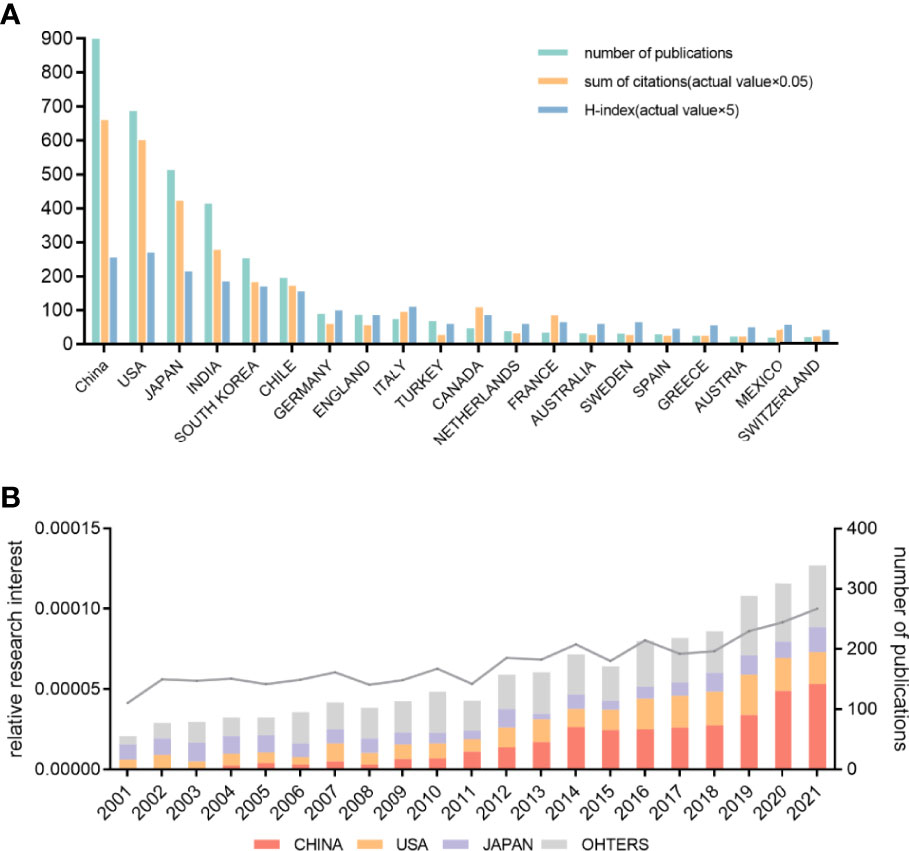
Figure 2 Contributions to the gallbladder cancer research of different countries or regions. (A) The number of publications, sum of citations (*0.05), and H-index (*5) of the top 20 countries or regions. (B) The number of publications worldwide and the top 3 countries per year are shown in the histogram. Line chart shows the time course of relative research interest.
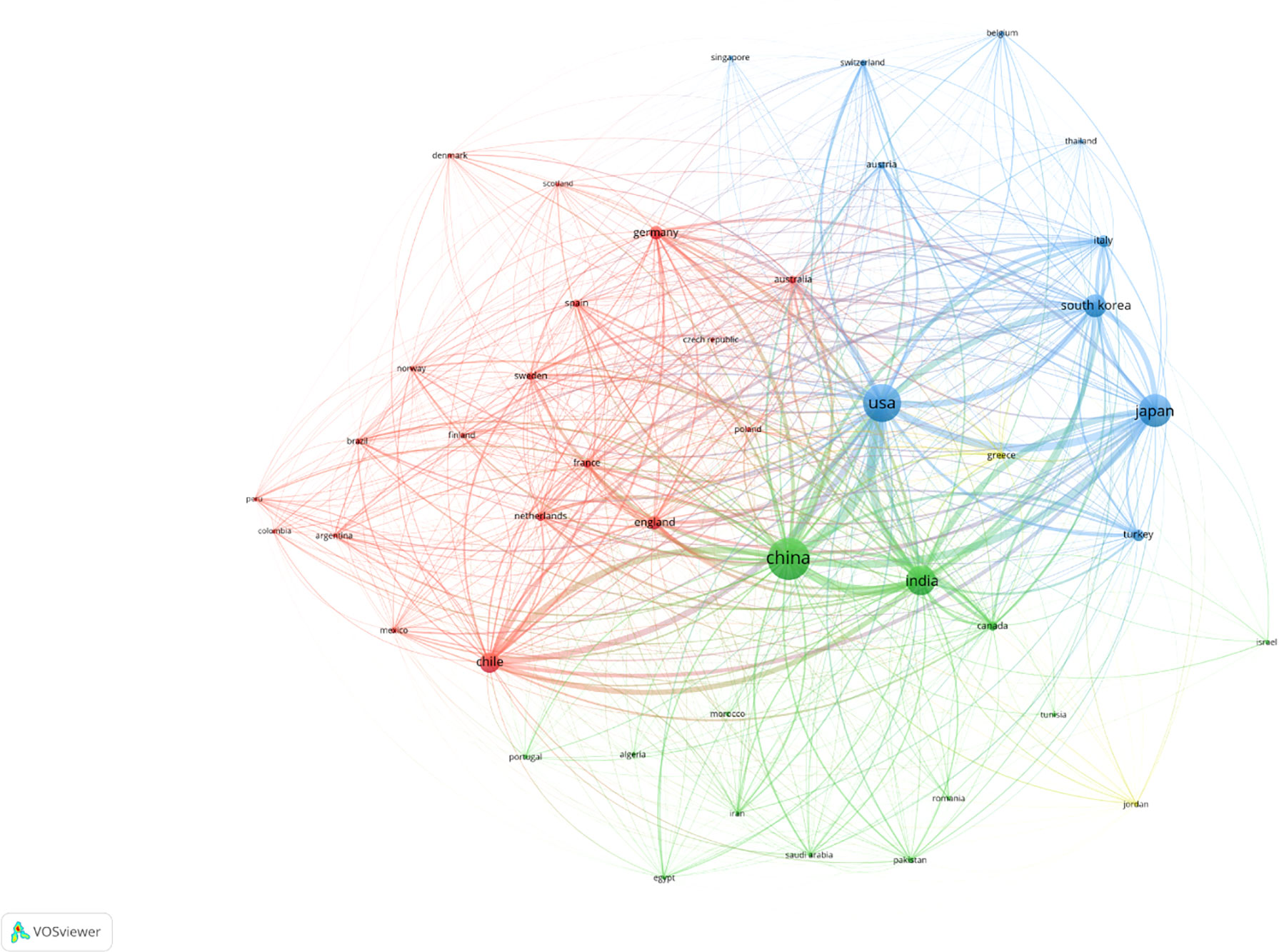
Figure 3 A visual network of countries publishing at least five gallbladder cancer research. All keywords were divided into four clusters and given different colors; the circle with a large sizer represented a higher frequency.
Publication Growth Trend Predictions
The model fitting curves of the growth in GBC research illustrate that the number of publications grew significantly associated with time (Figure 4) and the trends of publications in the following 5 years were estimated according to the cumulative number of the articles published over the past 20 years. Apparently, the cumulative number of publications increases steadily around the world, including in USA and India. The cumulative number of publications in Japan grew slowly from 2001 to 2010 and increased rapidly during the latest decade, while the cumulative number of publications in South Korea shows a trend of slowing down after rapid growth in the previous decade. China has exhibited significantly faster growth, resulting in the contribution of the most publications.
Journal Publishing Research and Institution Publishing Research
In terms of journals, the top 20 journals with the most publications in GBC research occupied one-third of the articles published in 2001–2021 (n = 1,040, 31.30%). Among them, Journal of Clinical Oncology published the most articles with 104 publications (Figure 5A). Gastroenterology comes in second with 95 publications, followed by Annals of Surgical Oncology, World Journal of Gastroenterology, and Modern Pathology with 76, 74, and 57 publications, respectively.
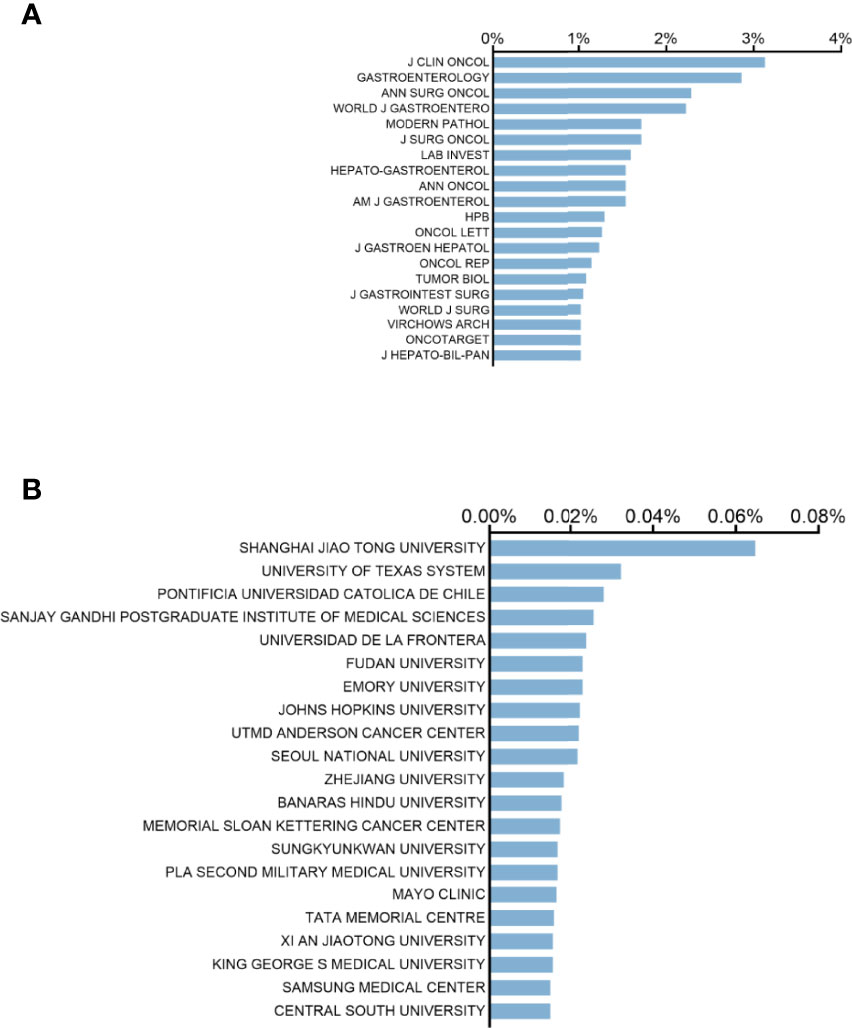
Figure 5 Distribution of journals and institutions focusing on gallbladder cancer. (A) Top 20 journals with the most publications in this field. (B) Top 20 institutions with the most publications in this field.
Shanghai Jiaotong University contributed the most publications (n = 215, 6.47%), far ahead of other institutions (Figure 5B). The University of Texas system ranked second with 107 articles published. Six of the top 20 institutions (Samsung Medical Center and Central South University are tied for 20th) are from China and USA, respectively, and four are from India. South Korean institutions and Chilean institutions contribute three and two, respectively.
Authors’ Publication on GBC Research
As shown in Table 1, Roa JC of Pontificia Universidad Catolica De Chile (n = 89, 2.68%), Liu YB of Shanghai Jiaotong University (n = 87, 2.62%), and Quan ZW (n = 55, 1.66%) were the most productive authors in GBC research. Within them, Wu XS, of Shanghai Jiaotong University, has 2,045 citations with only 47 papers. The top 10 authors each have more than 1,000 citations. Notably, eight of the top 10 authors are from Shanghai Jiaotong University. Considering that cooperation between researchers can highly improve the efficacy and quality, the cooperation network between authors with more than 10 publications is presented in Supplementary Figure 1. As shown in Supplementary Figure 1, authors from Shanghai Jiaotong University have close cooperation.
Publications With High Academic Impact on GBC Research
Publications with high academic impact tend to be cited frequently. We used WOS to filter out the publications with the most citations and list them, as shown in Table 2. Several publications clearly illustrated that the management and epidemiology of GBC were on the list. Interestingly, research on the Keap1/Nrf2 signaling pathway and LncRNA CCAT1 identified the mechanism of chemotherapy resistance and carcinogenesis in GBC.
Analysis of Keywords on GBC Research
All keywords that occurred more than 25 times were analyzed by using VOSviewer. After eliminating redundant synonyms and meaningless words, 101 keywords were identified and classified into five clusters: surgery therapy, mechanism research-related study, non-surgery therapy, epidemiology-related study, and pathology-related study (Figure 6A). Regarding surgery therapy, survival (n = 394), management (n = 222), cholecystectomy (n = 192), and diagnosis (n = 168) are the most frequent keywords. In mechanism research-related study, gallbladder cancer (n = 898), expression (n = 373), metastasis (n = 207), and proliferation (n = 143) are the most frequent keywords. With regard to pathology-related study, epidemiology-related study, and non-surgery therapy, prognosis (n = 290), adenocarcinoma (n = 163), chemotherapy (n = 156), gemcitabine (n = 141), epidemiology (n = 143), and risk (n = 120) are the most frequent keywords in their own clusters.
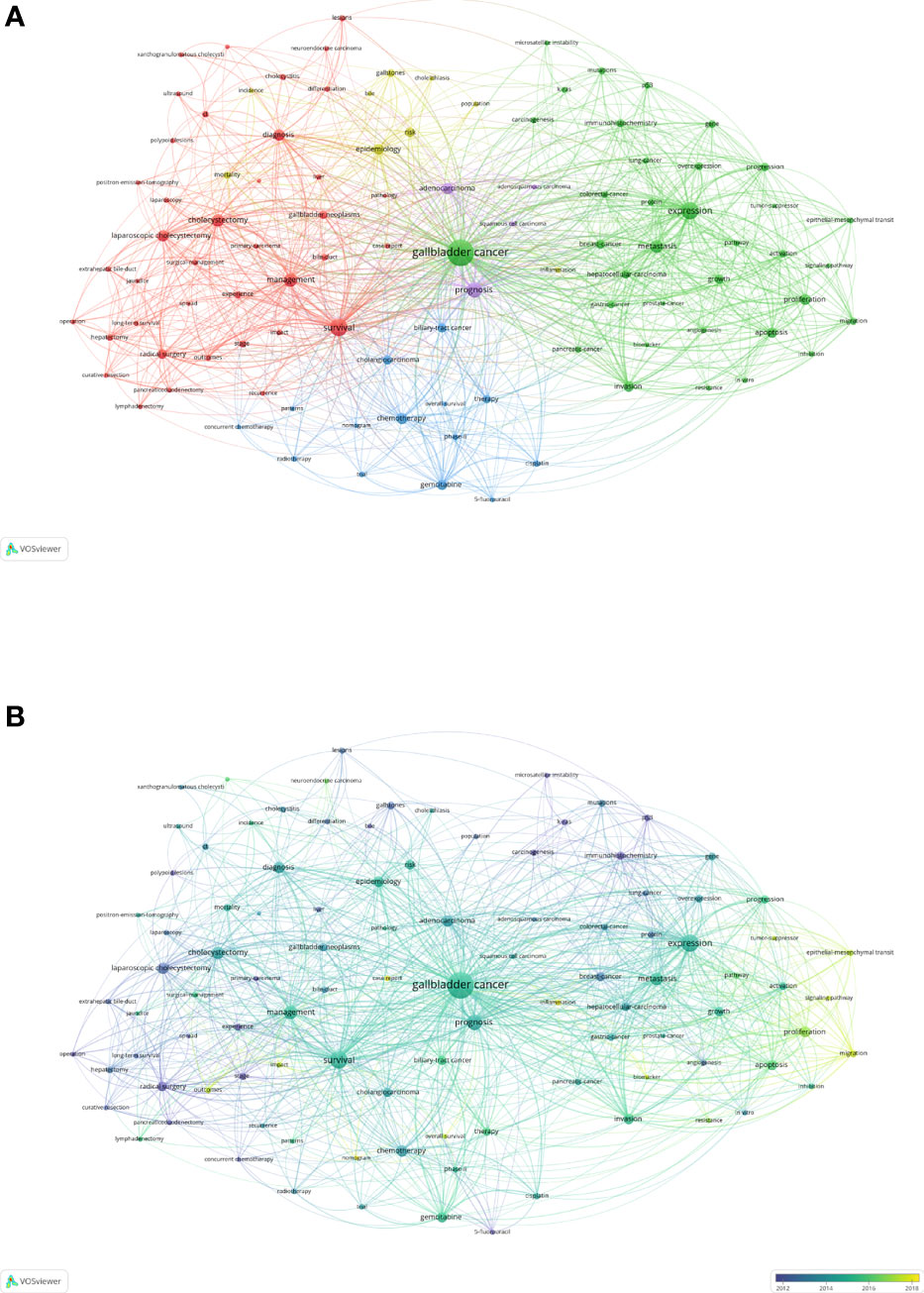
Figure 6 A visual network of the keywords in gallbladder cancer research. (A) Mapping of the keywords. All keywords were classified into five clusters and given different colors. The larger size of circle represented a higher frequency. (B) Distribution based on the average time of appearance. The color of circles represents the year of appearance. Yellow indicates recent appearance, and blue indicates early appearance.
To illustrate the hotspots appearing in recent years on GBC research, we calculated the average appearing years (AAY) of keywords (Figure 6B). Keywords shown in yellow such as migration (cluster 2, AAY of 2017.4), biomarker (cluster 2, AAY of 2017.4), and nomogram (cluster3, AAY of 2019.6) appear most recently. Mechanism research-related study and non-surgery therapy may be a new research trend.
Discussion
Our study analyzed 3,323 GBC publications published in the past two decades. Surprisingly, our research indicates that China contributed the most publications and citations and a high H-index value in the area of GBC research. This may be due to China being one of the countries with the highest burden of GBC (3). Following China, the USA also made great contributions to GBC research. From three to six, Japan, India, South Korea, and Chile contributed about one-third of total publications. These four countries are among the countries with the highest burden of GBC over the world, with Chile having a very high incidence of 5.6 cases per 100,000 people (3, 15, 16). Besides, the poor prognosis of GBC may be the reason for the large number of publications in GBC research. It is reported that the median survival time of GBC patients is less than 1 year and the 5-year overall survival is only 5% (17).
As illustrated in the network of countries’ cooperation, the highest link strength was between China and USA, which have extensive cooperation and exchanges in the new century. There are also frequent communications between China and India, China and Japan, and the USA and Japan, showing the international cooperation between these countries with numerous publications.
As shown in the cumulative curve of publications, global research on GBC has increased steadily over time. Notably, the time curve of China started off slowly but increased dramatically and showed the fastest growth rate. Nevertheless, the increase rate of South Korea’s time curve declined and increased mildly, which could account for the descendent trend of incidence in Korea from 2005 to 2015 (18, 19).
Journals in oncology and gastrointestinal diseases such as Journal of Clinical Oncology, Gastroenterology, and Annals of Surgical Oncology were the primary journals publishing research on GBC. World Journal of Gastroenterology also had a large number of publications. Therefore, it is reasonable to predict that future developments in the field will be more likely published in these journals. Among the 104 publications published by Journal of Clinical Oncology, 102 publications were consistent with abstracts, leading to change in clinical trials and therapy in GBC research (data not shown). Excluding meeting abstracts, World Journal of Gastroenterology published the most articles in GBC research (n = 74).
Within the top 20 institutions in surgical training, six institutions from China and USA, respectively, demonstrate their dominant status in this field. Regarding authors, Roa JC from Pontificia Universidad Catolica De Chile and Liu YB and Quan ZW from Shanghai Jiaotong University had published the most papers on GBC research. These scholars were considered to be pioneers in this field, and their studies will continue to influence future research development and guide cutting-edge research. Interestingly, as shown in Table 1 and Figure S1, Liu YB’s team, Gong W’s team, and Wang J’s team contributed to most of the research published by Shanghai Jiaotong University. A cooperative but also competitive relationship between these three teams was clearly revealed by the network map.
A network analysis of literature keywords demonstrated the research interests and divided them into five clusters. The three major clusters were surgery therapy, mechanism research-related study, and non-surgery therapy, representing the clinical research and basic research. Radical surgery remains the only curative treatment for resectable GBC (20). Since only 10% of patients have the opportunity of a radical resection, systemic therapy became an important subject of research (21, 22). Along with the development and deeper perception of oncogenesis and perioperative management of GBC, a better paradigm of chemotherapies and more targeted therapy and immune therapy lead to a better prognosis for patients with GBC (9, 10, 23). Regarding the mechanism research-related study, the molecular mechanism in different hallmarks of GBC, especially the role and regulated pathway of high-frequency mutations of Erbb2, can bring us a deeper understanding and provide a novel therapeutic target for GBC (12, 24, 25). By time-series analysis, the network map showed that migration, biomarker, and nomogram had appeared most recently. This result demonstrated that mechanism study remains a hot research topic in GBC research and the mechanism in migration of GBC is a research priority, as lymph node metastasis is the key factor in the clinical staging of GBC. Additionally, because of the poor prognosis, finding better diagnostic and prognostic biomarkers and nomograms for prognosis and metastasis can improve the efficacy of personalized therapy and the survival of GBC patients. Bibliometrics is a quantitative analysis method based on mathematics and statistics. Using a visualization model can present the time sequence and clustering of keywords in the literature reflecting the interaction network, which is of great significance to scientific research evaluation. This study made an evidence-based visualization analysis of English publications to clarify the current hotspots of GBC research. However, the study still has limitations. The English publications are solely based on the WoSCC database with the exclusion of other English databases, which may cause some bias. Literatures with the non-standard use of keywords may lead to omissions in the literature retrieval based on these search strategies, which may affect the results and accuracy of cluster analysis. Moreover, the latest publications which do not have enough time to accumulate considerable citations were not included, which may partially affect our conclusions.
The study has demonstrated publication trends in GBC research. China and USA have contributed the most research and play important roles as the leading contributors. Other countries like Japan, India, South Korea, and Chile have also made great contribution to GBC research. Research in GBC has developed steadily and rapidly in the past two decades. By keywords analysis, the hotspots of GBC are mainly related to surgery therapy, mechanism research-related study, and non-surgery therapy. Elucidating deeper mechanisms in the migration of GBC cells, new biomarkers and highly effective nomograms will be the major problems and research directions in the future.
Data Availability Statement
The original contributions presented in the study are included in the article/Supplementary Material. Further inquiries can be directed to the corresponding authors.
Author Contributions
All authors made substantive intellectual contributions to the study. SS and LH design the conception of the study. SW, SS and LH modified the design of the study. GZ and ST collected the data. SW and WW performed the study and analyzed the data. SW and WW drafted the Introduction, Result and Discussion sections. GZ drafted the Methods sections. SW, SS and LH edited the manuscript. All authors have agreed to be accountable for all aspects of the work in ensuring that questions related to the accuracy or integrity of any part of the work are appropriately investigated and resolved. All authors contributed to the article and approved the submitted version.
Funding
This research was funded by the National Natural Science Foundation of China (No. 82072682), Natural Science Foundation of Shanghai (21ZR1459100), and Science and Technology Commission of Shanghai Municipality (20DZ2254500).
Conflict of Interest
The authors declare that the research was conducted in the absence of any commercial or financial relationships that could be construed as a potential conflict of interest.
Publisher’s Note
All claims expressed in this article are solely those of the authors and do not necessarily represent those of their affiliated organizations, or those of the publisher, the editors and the reviewers. Any product that may be evaluated in this article, or claim that may be made by its manufacturer, is not guaranteed or endorsed by the publisher.
Supplementary Material
The Supplementary Material for this article can be found online at: https://www.frontiersin.org/articles/10.3389/fonc.2022.932797/full#supplementary-material
Supplementary Figure 1 | A visual network of the authors publishing more than 10 publications in gallbladder cancer research. All authors were divided into 9 clusters.
References
1. Lazcano-Ponce EC, Miquel JF, Munoz N, Herrero R, Ferrecio C, Alonso De Ruiz P, et al. Epidemiology And Molecular Pathology Of Gallbladder Cancer. CA Cancer J Clin (2001) 51:349–64. doi: 10.3322/canjclin.51.6.349
2. Zhu AX, Hong TS, Hezel AF, Kooby DA. Current Management Of Gallbladder Carcinoma. Oncologist (2010) 15:168–81. doi: 10.1634/theoncologist.2009-0302
3. Are C, Ahmad H, Ravipati A, Croo D, Clarey D, Smith L, et al. Global Epidemiological Trends And Variations In The Burden Of Gallbladder Cancer. J Surg Oncol (2017) 115:580–90. doi: 10.1002/jso.24546
4. Nagino M, Hirano S, Yoshitomi H, Aoki T, Uesaka K, Unno M, et al. Clinical Practice Guidelines For The Management Of Biliary Tract Cancers 2019: The 3rd English Edition. J Hepatobil Pancreat Sci (2021) 28:26–54. doi: 10.1002/jhbp.870
5. National Comprehensive Cancer Network. NCCN Clinical Practice Guidelines In Oncology - Hepatobiliary Cancers (Version 1.2022) (2022) https://www.nccn.org/professionals/physician_gls/pdf/hepatobiliary.pdf.
6. Hundal R, Shaffer EA. Gallbladder Cancer: Epidemiology and Outcome. Clin Epidemiol (2014) 6:99–109. doi: 10.2147/CLEP.S37357
7. Valle J, Wasan H, Palmer DH, Cunningham D, Anthoney A, Maraveyas A, et al. Cisplatin Plus Gemcitabine Versus Gemcitabine For Biliary Tract Cancer. N Engl J Med (2010) 362:1273–81. doi: 10.1056/NEJMoa0908721
8. Lamarca A, Hubner RA, David Ryder W, Valle JW. Second-Line Chemotherapy In Advanced Biliary Cancer: A Systematic Review. Ann Oncol (2014) 25:2328–38. doi: 10.1093/annonc/mdu162
9. Demols A, Borbath I, Van Den Eynde M, Houbiers G, Peeters M, Marechal R, et al. Regorafenib After Failure Of Gemcitabine And Platinum-Based Chemotherapy For Locally Advanced/Metastatic Biliary Tumors: REACHIN, A Randomized, Double-Blind, Phase II Trial. Ann Oncol (2020) 31:1169–77. doi: 10.1016/j.annonc.2020.05.018
10. Kim RD, Chung V, Alese OB, El-Rayes BF, Li D, Al-Toubah TE, et al. A Phase 2 Multi-Institutional Study Of Nivolumab For Patients With Advanced Refractory Biliary Tract Cancer. JAMA Oncol (2020) 6:888–94. doi: 10.1001/jamaoncol.2020.0930
11. Le DT, Durham JN, Smith KN, Wang H, Bartlett BR, Aulakh LK, et al. Mismatch Repair Deficiency Predicts Response Of Solid Tumors To PD-1 Blockade. Science (2017) 357:409–13. doi: 10.1126/science.aan6733
12. Li M, Liu F, Zhang F, Zhou W, Jiang X, Yang Y, et al. Genomic ERBB2/ERBB3 Mutations Promote PD-L1-Mediated Immune Escape In Gallbladder Cancer: A Whole-Exome Sequencing Analysis. Gut (2019) 68:1024–33. doi: 10.1136/gutjnl-2018-316039
13. Zhang Y, Zuo C, Liu L, Hu Y, Yang B, Qiu S, et al. Single-Cell RNA-Sequencing Atlas Reveals An MDK-Dependent Immunosuppressive Environment In Erbb Pathway-Mutated Gallbladder Cancer. J Hepatol (2021) 75:1128–41. doi: 10.1016/j.jhep.2021.06.023
14. Li M, Zhang Z, Li X, Ye J, Wu X, Tan Z, et al. Whole-Exome and Targeted Gene Sequencing of Gallbladder Carcinoma Identifies Recurrent Mutations In The Erbb Pathway. Nat Genet (2014) 46:872–6. doi: 10.1038/ng.3030
15. Huang J, Patel HK, Boakye D, Chandrasekar VT, Koulaouzidis A, Lucero-Prisno Iii DE, et al. Worldwide Distribution, Associated Factors, And Trends Of Gallbladder Cancer: A Global Country-Level Analysis. Cancer Lett (2021) 521:238–51. doi: 10.1016/j.canlet.2021.09.004
16. Ferlay J EM, Lam F, Colombet M, Mery L, Piñeros M, Znaor A, et al. Global Cancer Observatory: Cancer Today. Lyon, France: International Agency For Research On Cancer. [Online] (2020). p. 4.10 2020.
17. Mao W, Deng F, Wang D, Gao L, Shi X. Treatment of Advanced Gallbladder Cancer: A SEER-Based Study. Cancer Med (2020) 9:141–50. doi: 10.1002/cam4.2679
18. Wi Y, Woo H, Won YJ, Jang JY, Shin A. Trends In Gallbladder Cancer Incidence And Survival In Korea. Cancer Res Treat (2018) 50:1444–51. doi: 10.4143/crt.2017.279
19. Kim BW, Oh CM, Choi HY, Park JW, Cho H, Ki M. Incidence and Overall Survival Of Biliary Tract Cancers In South Korea From 2006 To 2015: Using The National Health Information Database. Gut Liv (2019) 13:104–13. doi: 10.5009/gnl18105
20. Vega EA, Mellado S, Salehi O, Freeman R, Conrad C. Treatment of Resectable Gallbladder Cancers. Cancers (Basel) (2022) 14(6):1413. doi: 10.3390/cancers14061413
21. Valle JW, Kelley RK, Nervi B, Oh DY, Zhu AX. Biliary Tract Cancer. Lancet (2021) 397:428–44. doi: 10.1016/S0140-6736(21)00153-7
22. Kam AE, Masood A, Shroff RT. Current And Emerging Therapies For Advanced Biliary Tract Cancers. Lancet Gastroenterol Hepatol (2021) 6:956–69. doi: 10.1016/S2468-1253(21)00171-0
23. Lamarca A, Palmer DH, Wasan HS, Ross PJ, Ma YT, Arora A, et al. Second-Line FOLFOX Chemotherapy Versus Active Symptom Control For Advanced Biliary Tract Cancer (ABC-06): A Phase 3, Open-Label, Randomised, Controlled Trial. Lancet Oncol (2021) 22:690–701. doi: 10.1016/S1470-2045(21)00027-9
24. Rizzo A, Ricci AD, Bonucci C, Tober N, Palloni A, Frega G, et al. Experimental HER2- Targeted Therapies For Biliary Tract Cancer. Expert Opin Investig Drugs (2021) 30:389–99. doi: 10.1080/13543784.2021.1854724
Keywords: Gallbladder cancer (GBC), bibliometric analysis, publication, citation, research
Citation: Sun W, Wan W, Gao Z, Suo T, Shen S and Liu H (2022) Publication Trends of Research on Gallbladder Cancer During 2001–2021: A 20-Year Bibliometric Analysis. Front. Oncol. 12:932797. doi: 10.3389/fonc.2022.932797
Received: 30 April 2022; Accepted: 14 June 2022;
Published: 11 July 2022.
Edited by:
Xiangsong Wu, Shanghai Jiao Tong University School of Medicine, ChinaReviewed by:
Jinhui Zhu, Zhejiang University, ChinaZhaohui Tang, Shanghai Jiao Tong University, China
Copyright © 2022 Sun, Wan, Gao, Suo, Shen and Liu. This is an open-access article distributed under the terms of the Creative Commons Attribution License (CC BY). The use, distribution or reproduction in other forums is permitted, provided the original author(s) and the copyright owner(s) are credited and that the original publication in this journal is cited, in accordance with accepted academic practice. No use, distribution or reproduction is permitted which does not comply with these terms.
*Correspondence: Houbao Liu, enNsaXVoYkBzaW5hLmNu; Sheng Shen, c2hlbi5zaGVuZ0B6cy1ob3NwaXRhbC5zaC5jbg==
†These authors have contributed equally to this work
 Wentao Sun
Wentao Sun Wenze Wan
Wenze Wan Zhihui Gao
Zhihui Gao Tao Suo
Tao Suo Sheng Shen
Sheng Shen Houbao Liu
Houbao Liu